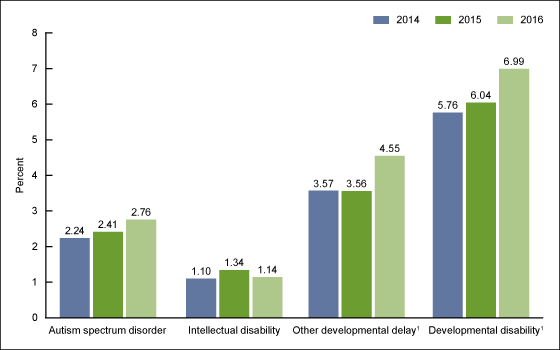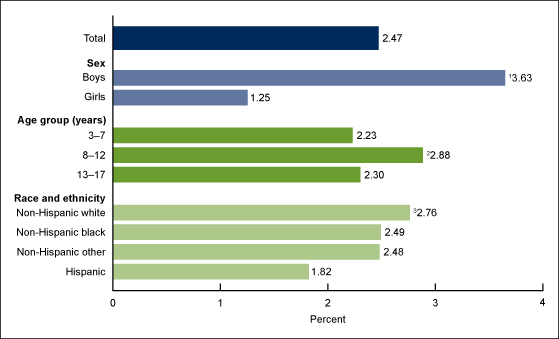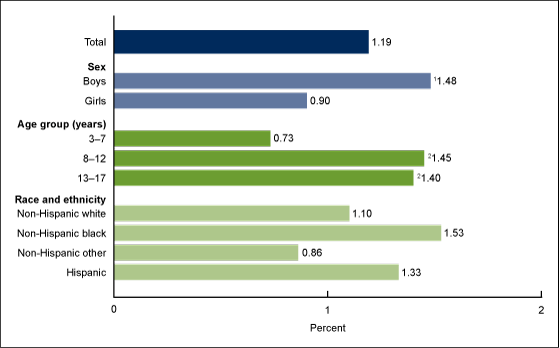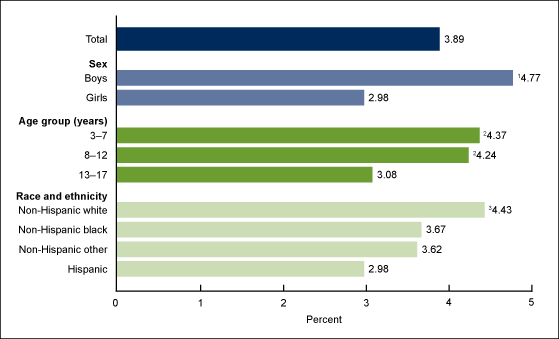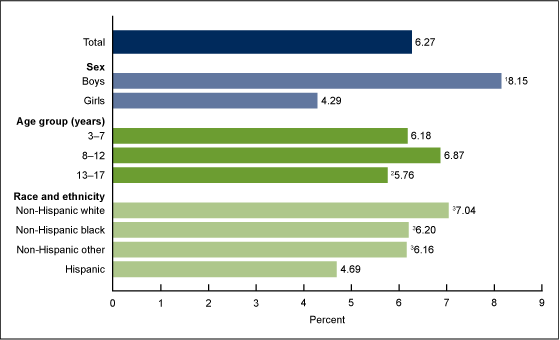Estimated Prevalence of Children With Diagnosed Developmental Disabilities in the United States, 2014–2016
- Key findings
- The prevalence of children diagnosed with any developmental disability increased from 2014 to 2016.
- A higher percentage of boys have been diagnosed with autism spectrum disorder compared with girls.
- The prevalence of diagnosed intellectual disability was higher among boys than girls.
- The prevalence of children ever diagnosed with developmental delay other than autism spectrum disorder or intellectual disability was lowest among older children.
- The prevalence of developmental disabilities was lowest among Hispanic children.
- Summary
- Definitions
- Data source and methods
- About the authors
- References
- Suggested citation
NCHS Data Brief No. 291, November 2017
PDF Version (611 KB)
Benjamin Zablotsky, Ph.D., Lindsey I. Black, M.P.H., and Stephen J. Blumberg, Ph.D.
Key findings
Data from the National Health Interview Survey
- During 2014–2016, the prevalence of children aged 3–17 years who had ever been diagnosed with a developmental disability increased from 5.76% to 6.99%.
- During this same time, the prevalence of diagnosed autism spectrum disorder and intellectual disability did not change significantly.
- The prevalence of autism spectrum disorder, intellectual disability, other developmental delay, and any developmental disability was higher among boys compared with girls.
- The prevalence of any developmental disability was lower among Hispanic children compared with children in all other race and ethnicity groups.
Developmental disabilities are a set of heterogeneous disorders characterized by difficulties in one or more domains, including but not limited to, learning, behavior, and self-care. This report provides the latest prevalence estimates for diagnosed autism spectrum disorder, intellectual disability, and other developmental delay among children aged 3–17 years from the 2014–2016 National Health Interview Survey (NHIS). Estimates are also presented for any developmental disability, defined as having had one or more of these three diagnoses. Prevalence estimates are based on parent or guardian report of ever receiving a diagnosis of each developmental disability from a doctor or other health care professional.
Keywords: autism spectrum disorder, National Health Interview Survey
The prevalence of children diagnosed with any developmental disability increased from 2014 to 2016.
- During 2014–2016, the prevalence of children ever diagnosed with any developmental disability significantly increased, from 5.76% in 2014 to 6.99% in 2016 (Figure 1).
- The prevalence of children ever diagnosed with a developmental delay other than autism spectrum disorder or intellectual disability increased, from 3.57% in 2014 to 4.55% in 2016.
- There was not a statistically significant change in the prevalence of children ever diagnosed with autism spectrum disorder from 2014 to 2016.
- The prevalence of children ever diagnosed with intellectual disability did not significantly change from 2014 to 2016.
Figure 1. Prevalence of children aged 3–17 years ever diagnosed with selected developmental disabilities, by year: United States, 2014–2016
1Linear increase from 2014 to 2016 is statistically significant (p < 0.05).
NOTES: Developmental disability includes autism spectrum disorder, intellectual disability, and any other developmental delay. Access data table for Figure 1.
SOURCE: NCHS, National Health Interview Survey, 2014–2016.
A higher percentage of boys have been diagnosed with autism spectrum disorder compared with girls.
- During 2014–2016, the prevalence of children diagnosed with autism spectrum disorder was higher among boys (3.63%) than girls (1.25%) (Figure 2).
- Non-Hispanic white children (2.76%) were more likely to have been diagnosed with autism spectrum disorder than Hispanic children (1.82%).
- Children aged 8–12 years (2.88%) were more likely to have been diagnosed with autism spectrum disorder than children aged 3–7 years (2.23%).
- The difference in the prevalence of children diagnosed with autism spectrum disorder between the ages of 8–12 (2.88%) and 13–17 (2.30%) years was not statistically significant (p = 0.06).
Figure 2. Prevalence of children aged 3–17 years ever diagnosed with autism spectrum disorder, by sex, age, and race and ethnicity: United States, 2014–2016
1Significantly different from girls (p < 0.05).
2Significantly different from children aged 3–7 years (p < 0.05).
3Significantly different from Hispanic children (p < 0.05).
NOTE: Access data table for Figure 2.
SOURCE: NCHS, National Health Interview Survey, 2014–2016.
The prevalence of diagnosed intellectual disability was higher among boys than girls.
- During 2014–2016, the prevalence of children ever diagnosed with intellectual disability was 1.48% among boys and 0.90% among girls (Figure 3).
- The prevalence of intellectual disability was lower among younger children than older children: 0.73% among children aged 3–7 years, 1.45% among children aged 8–12 years, and 1.40% among children aged 13–17 years.
- The prevalence of children diagnosed with intellectual disability did not differ significantly by race and Hispanic ethnicity.
- The difference in the prevalence of intellectual disability between non-Hispanic black children (1.53%) and non-Hispanic other children (0.86%) was not statistically significant (p = 0.21).
Figure 3. Prevalence of children aged 3–17 years ever diagnosed with intellectual disability, by sex, age, and race and ethnicity: United States, 2014–2016
1Significantly different from girls (p < 0.05).
2Significantly different from children aged 3–7 years (p < 0.05).
NOTE: Access data table for Figure 3.
SOURCE: NCHS, National Health Interview Survey, 2014–2016.
The prevalence of children ever diagnosed with developmental delay other than autism spectrum disorder or intellectual disability was lowest among older children.
- The prevalence of other developmental delay was higher among boys (4.77%) than girls (2.98%) (Figure 4).
- During 2014–2016, children aged 3–7 (4.37%) and 8–12 (4.24%) years had a higher prevalence of other developmental delay compared with children aged 13–17 years (3.08%).
- Non-Hispanic white children (4.43%) had a higher prevalence of other developmental delay compared with Hispanic children (2.98%).
Figure 4. Prevalence of children aged 3–17 years ever diagnosed with other developmental delay, by sex, age, and race and ethnicity: United States, 2014–2016
1Significantly different from girls (p < 0.05).
2Significantly different from children aged 13–17 years (p < 0.05).
3Significantly different from Hispanic children (p < 0.05).
NOTE: Access data table for Figure 4.
SOURCE: NCHS, National Health Interview Survey, 2014–2016.
The prevalence of developmental disabilities was lowest among Hispanic children.
- The prevalence of developmental disabilities was higher among boys (8.15%) than girls (4.29%) (Figure 5).
- Children aged 13–17 years (5.76%) were less likely to have been diagnosed with any developmental disability than children aged 8–12 years (6.87%).
- During 2014–2016, Hispanic children (4.69%) were less likely to have been diagnosed with any developmental disability compared with non-Hispanic white children (7.04%), non-Hispanic black children (6.20%), and non-Hispanic other children (6.16%).
Figure 5. Prevalence of children aged 3–17 years ever diagnosed with any developmental disability, by sex, age, and race and ethnicity: United States, 2014–2016
1Significantly different from girls (p < 0.05).
2Significantly different from children aged 8–12 years (p < 0.05).
3Significantly different from Hispanic children (p < 0.05).
NOTE: Access data table for Figure 5.
SOURCE: NCHS, National Health Interview Survey, 2014–2016.
Summary
During 2014–2016, there was a significant increase in the prevalence of children who had ever been diagnosed with any developmental disability. This increase was largely the result of an increase in the prevalence of children diagnosed with a developmental delay other than autism spectrum disorder or intellectual disability. There was not a significant change in the prevalence of diagnosed autism spectrum disorder or intellectual disability over the same time period.
The prevalence of developmental disabilities described in this report is lower than findings described in previous reports using NHIS data (1). This report uses a more restrictive definition for a developmental disability that does not include conditions such as attention-deficit/hyperactivity disorder or learning disabilities, which may account for differences in estimates. A similar definition was used in a 2015 National Health Statistics Report (2).
For each condition examined, the prevalence was significantly higher among boys than girls, a finding common among children diagnosed with a developmental disability (1,3). The prevalence of any developmental disability diagnosis was lowest among Hispanic children compared with all other race and ethnicity groups; racial and ethnic disparities in the prevalence of developmental disabilities are findings commonly reported in the scientific literature (1,4). Prevalence among age groups varied by condition, which may reflect recent improvements in awareness and screening for developmental delay, resulting in younger cohorts having a higher diagnosed prevalence (4). However, for some children with less severe impairment, developmental disabilities, such as autism spectrum disorder and intellectual disability, may not be diagnosed until the child enters school and is observed by trained teachers (5).
Definitions
Diagnosed intellectual disability: Based on a positive response to the survey question, “Has a doctor or health professional ever told you that [sample child] had an intellectual disability, also known as mental retardation?”
Diagnosed autism spectrum disorder: Based on a positive response to the survey question, “Has a doctor or health professional ever told you that [sample child] had Autism, Asperger’s disorder, pervasive developmental disorder, or autism spectrum disorder?”
Diagnosed other developmental delay: Based on a positive response to the survey question, “Has a doctor or health professional ever told you that [sample child] had any other developmental delay?”
Diagnosed developmental disability: A composite measure of children with a diagnosis of autism spectrum disorder, intellectual disability, or any other developmental delay.
Race and ethnicity: Based on two separate questions that determine Hispanic or Latino origin and race. Persons of Hispanic or Latino origin may be of any race.
Data source and methods
Data from the 2014–2016 NHIS were used for this analysis. NHIS is a nationally representative survey of the civilian noninstitutionalized U.S. population. It is conducted continuously throughout the year by the National Center for Health Statistics (NCHS). NHIS is an in-person interview conducted in the respondent’s home. In some instances, follow-up to complete the interview is conducted via telephone. The survey consists of (a) the Family Core component, which collects information on all family members; (b) the Sample Adult component, which collects additional information from one randomly selected adult per family; and (c) the Sample Child component, which collects additional information about one randomly selected child per family. The sample child component is completed by a family respondent, usually the parent (approximately 91% of all cases). Data for this analysis come from the Sample Child and Family Core components of NHIS. For more information about NHIS, visit https://www.cdc.gov/nchs/nhis.htm.
NHIS is designed to yield a nationally representative sample, and these analyses used weights to produce national estimates. The sample design is described in more detail elsewhere (6). Point estimates and the corresponding variances for this analysis were calculated using SUDAAN software (7) to account for the complex sample design of NHIS. Linear and quadratic trends over time and differences between percentages were evaluated using two-sided significance tests at the 0.05 level.
About the authors
Benjamin Zablotsky, Lindsey I. Black, and Stephen J. Blumberg are with the National Center for Health Statistics, Division of Health Interview Statistics.
References
- Boyle CA, Boulet S, Schieve LA, Cohen RA, Blumberg SJ, Yeargin-Allsopp M, et al. Trends in the prevalence of developmental disabilities in US children, 1997–2008. Pediatrics 127(6):1034–42. 2011.
- Zablotsky B, Black LI, Maenner MJ, Schieve LA, Blumberg SJ. Estimated prevalence of autism and other developmental disabilities following questionnaire changes in the 2014 National Health Interview Survey. National Health Statistics Reports; no 87. Hyattsville, MD: National Center for Health Statistics. 2015.
- Maenner MJ, Blumberg SJ, Kogan MD, Christensen D, Yeargin-Allsopp M, Schieve LA. Prevalence of cerebral palsy and intellectual disability among children identified in two U.S. national surveys, 2011–2013. Ann Epidemiol 26(3):222–6. 2016.
- Christensen DL, Baio J, Van Naarden Braun K, Bilder D, Charles J, Constantino JN, et al. Prevalence and characteristics of autism spectrum disorder among children aged 8 years—Autism and Developmental Disabilities Monitoring Network, 11 sites, United States, 2012. MMWR Morb Mortal Wkly Rep 65(3):1–23. 2016.
- Johnson CP, Myers SM. Identification and evaluation of children with autism spectrum disorders. Pediatrics 120(5):1183–215. 2007.
- Parsons VL, Moriarity C, Jonas K, Moore TF, Davis KE, Tompkins L. Design and estimation for the National Health Interview Survey, 2006–2015. National Center for Health Statistics. Vital Health Stat 2(165). 2014.
- RTI International. SUDAAN (Release 11.0.0) [computer software]. 2012.
Suggested citation
Zablotsky B, Black LI, Blumberg SJ. Estimated prevalence of children with diagnosed developmental disabilities in the United States, 2014–2016. NCHS Data Brief, no 291. Hyattsville, MD: National Center for Health Statistics. 2017.
Copyright information
All material appearing in this report is in the public domain and may be reproduced or copied without permission; citation as to source, however, is appreciated.
National Center for Health Statistics
Charles J. Rothwell, M.S., M.B.A., Director
Jennifer H. Madans, Ph.D., Associate Director for Science
Division of Health Interview Statistics
Stephen J. Blumberg, Ph.D., Acting Director
Stephen J. Blumberg, Ph.D., Associate Director for Science
